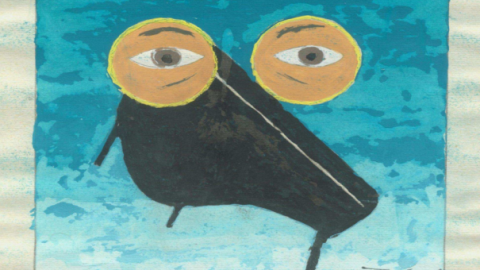Painting The Town Vermillion

I went from the paintings, prints and poetry of John Lennon to the paintings and prints of William Tolliver in twenty four hours this weekend. Friday night, instead of parking myself in front of my computer, I was talked into taking a ride down to Buckhead to see an exhibition of art works by John Lennon, who was more famous for the work he did on his day job as a member of the Beatles.
It was fun, although I realized as I walked around the exhibit that I really didn’t know that much about Lennon other than the name of his last residence, the Dakota, and the name of his widow, Yoko Ono. The few Beatles songs I’d heard over and over in my youth had blended into the cacophony of disparate music collections blaring out of the rooms in the dorm where I lived as a freshman. My coming of age years didn’t revolve around the crooning of the four young musicians from Liverpool but the middle age howls of the bluesmen like B.B. King from Beale Street and Muddy Waters from Chicago and the thunderous bass that drove the testosterone fueled braggadocio of baby faced rappers from New York.
The Lennon lithographs and poetry were displayed in a hotel right beside Lenox Mall whose lobby was filled with fans in town for the SEC championship football game at the Georgia Dome. Family groups drifted from piece to piece, the parents often dreamy eyed, the children nonplussed. An occasional raised eyebrow and questioning stare, meant to remind us that our threesome were the only African Americans in the room, was sad yet amusing—didn’t Lennon choose an Asian woman as his second bride and write songs about love and harmony?
I immediately understood, though, as I read the poetry Lennon had rendered as works of art, what was behind the obsessive love his fans have for his works. Serious poets take great care with the meanings and the juxtaposition of the words they use. To this unfamiliar observer, who had spent all of half an hour immersed in the images and lyrics John Lennon created throughout his life, it seemed apparent that the power of language was more important than melody to him.
If the weekend had ended there, I would have been aesthetically fulfilled. Except the art auction the next night had been on the schedule for weeks. The host is always so entertaining that at times it seems like I am at a cabaret instead of an annual fund raiser for Morehouse College, the host’s alma mater. And I always look forward to chewing the fat with the eclectic group of well read and sometimes well connected guests that come together for this event year after year.
In some ways, the contrast of the Lennon showing on Friday added a heightened level of poignancy to Saturday night’s atmosphere. I was witnessing in the flesh a small cadre of black artists milling around the gallery, many of whom who had been working since Lennon exploded on the world stage back in the sixties. Producing art is their day job, and it shows. These men and women are still alive forty five years later, still putting out their own visions of the world, still dealing with the same basic paradoxes about the meaning of life, one canvas at a time.
Nevertheless, John Lennon’s fans are privy to the same thing William Tolliver’s fans and art lovers around the world seek access to—the mythical power of a work of art to describe the abyss that houses the human spirit.





